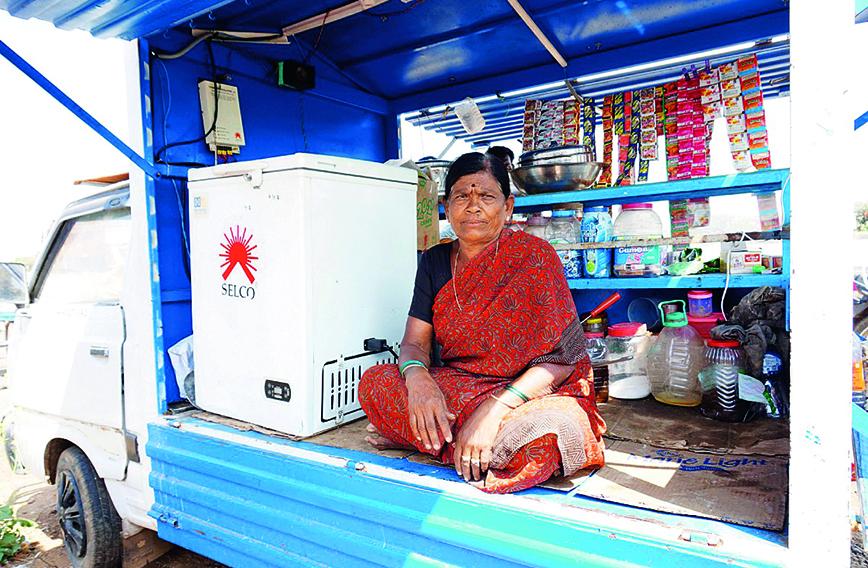
A solar fridge: Cooling in the middle of nowhere
Social enterprises doing well with more support
Madhukar Shukla
 SOCIAL entrepreneurship has been around for a long while, but a spurt in its growth was witnessed after 2002 when 10 outstanding social entrepreneurs from India and Bangladesh were recognized for their contribution at the India Economic Summit of the World Economic Forum.
SOCIAL entrepreneurship has been around for a long while, but a spurt in its growth was witnessed after 2002 when 10 outstanding social entrepreneurs from India and Bangladesh were recognized for their contribution at the India Economic Summit of the World Economic Forum.
They were felicitated by the then President, Dr A.P.J. Abdul Kalam, and thereafter social entrepreneurship found official acceptance and currency.
The next five to six years saw an increase in activities and initiatives related to social entrepreneurship in India.
A 2012 study, Landscape of Social Enterprise in India, carried out by Intellecap, noted: “Nearly half of the enterprises in our survey have been operational for less than three years, and nearly 80 percent launched operations in 2007 or later. The take-off appears to have occurred in 2005-2006.”
The distinctive aspect of this growth has been the innovations which Indian social entrepreneurs made in problem identification and developing new solutions.
In a way, India provides fertile ground for such innovations. Despite being a resource-rich country, India also hosts a disproportionate number of people who lack access to basic education, primary healthcare, clean water and energy, linkages to markets and justice.
Social innovations, or finding innovative, sustainable and scalable ways to bridge this “unequal access” to basic societal resources and amenities has been a pervasive feature of Indian social entrepreneurship.
To cite a few examples of such innovations: Haqdarshak provides technical and field-based assistance to marginalized and illiterate communities to help them avail of the benefits of government welfare schemes.
Ventures such as Ekgaon, DeHaat and Samriddhi work to increase incomes of small and marginal farmers by providing them technical inputs and connecting them to markets.
The Digital Empowerment Foundation has been working to bridge the digital divide among remote communities to enhance their access to information, markets and livelihoods.
From Operation ASHA comes the diagnosis and treatment of tuberculosis at the doorstep of marginalized communities at a nominal cost. And Hasiru Dala mobilizes, trains and enables wastepickers to leverage their skills to become “waste entrepreneurs”.
The list of such innovation is a long one and it continues to grow greater awareness and support for inclusion and equity.
Over the years, increasingly, the work of Indian social entrepreneurs has been recognized and felicitated on global platforms such as the World Economic Forum, Skoll World Forum at Oxford University, Schwab Foundation for Social Entrepreneurship, and the like.
The models and solutions developed by Indian social entrepreneurs have also been replicated in other regions, especially in the low-income countries of Africa and Latin America.
These achievements of Indian social entrepreneurs were paralleled by the growth of a supportive ecosystem of organizations and activities. Many of these organizations and initiatives were themselves entrepreneurial efforts which provided essential and customized services and resources to social entrepreneurs, and to seed new ventures. In the following paragraphs we will trace some of these developments which transformed an isolated field of practice into a vibrant sector.
A TALENT PIPELINE
For any sector to scale, the availability of skilled talent is essential. During the past two decades or so, two streams of initiatives have come up to create a pipeline of socially sensitive young people with the skills and orientation for social entrepreneurship.
On the academic side, the past two decades saw many academic institutes launching courses and programmes to prepare such a talent pipeline. Between 2004-07, six major educational institutions (IIM Ahmedabad, IIM Bengaluru, Indian Institute of Forest Management, Bhopal, Institute of Rural Management, Anand, Xavier Institute of Management, Bhubaneswar and XLRI, Jamshedpur) introduced courses in social entrepreneurship in their curriculum.
In 2007, the Mumbai-based Tata Institute of Social Sciences and Narsi Monjee Institute of Management Studies each launched a full-time two-year master’s programme in social entrepreneurship.
Over the years, such academic courses have proliferated. They are offered by many educational institutes such as Ambedkar University in Delhi, Gujarat National Law University, IIM Lucknow, Madras School of Social Work.
The University Grants Commission and the Atal Innovation Mission have started supporting and promoting Faculty Development Programmes to create a pool of social entrepreneurship educators.
FELLOWSHIPS
The other stream of initiatives was the rise of “fellowship programmes”, designed to sensitize and prepare the youth and students to understand and develop skills to address social issues. These fellowships provide one to three years’ immersive learning-by-doing experience during which the participants live and work in marginalized rural and urban communities, identify their social problems and develop and implement solutions to address them.
Fellowships have proliferated. Some of them are the Change Loom programme (by Pravah and Ashoka Youth Ventures in 2006) and the Gandhi Fellowship (by Piramal Foundation in 2007), the ICICI Fellowship (now India Fellow Programme), SBI Youth for India Fellowship, the Government of India’s Prime Minister’s Rural Development Fellowship and Mahatma Gandhi National Fellowship, SRIJAN’s The Buddha Fellowship, Disom Foundation’s Disom Leaders Fellowship, etc.
A review of some of these fellowships showed that more than half of their participants chose a career in social ventures, or started their own.
TECHNICAL SUPPORT
A related, and significant, development has been the emergence of a set of organizations which provide technical support services customized for social ventures.
Outfits such as 3rd Sector Partners and OpportuneJobs facilitate recruitment. Intellecap provides advisory services. Intellecap offers consultancy as do Sattva, Samhita and some others. SVP Partners promotes collaborations and partnerships. The impact of these services has been to make social enterprises more efficient and speed up the growth of the sector as a whole.
Important technical support came from social incubators which have proliferated during the past two decades. Starting with the founding of Dasra and Villgro (earlier Rural Innovation Network) in 2001-02, there are now estimated to be about 30 to 40 incubators specifically focused on both for-profit and not-for-profit social ventures. Some of the prominent ones which have had impact are Action for India, CIIE (Centre for Innovation, Incubation and Entrepreneurship) at IIM Ahmedabad, Incubation Centre at TISS in Mumbai, INVENT Social Incubation Programme at IIT Kanpur, iSEED at IRMA, Marico Innovation Foundation, N/Core, RTBI (Rural Technology Business Incubator) at IIT Madras, Tata Trust’s Social Alpha, StartUp!, UnLtd and so on.
Access to funds has grown over the past two decades both for for-profit and not-for-profit ventures. Equity/debt-based investments and philanthropic capital have opened new opportunities and challenges for social entrepreneurs.
Starting from the initial handful of social impact investors (Aavishkaar India Micro Venture Fund, Lok Capital, Acumen Fund and Elevar Equity), the Impact Investing Council of India now has around 60 active impact investors as members. Good returns from investments in for-profit social enterprises have also attracted traditional investors of commercial start-ups.
Impact investments have grown from $100 million about a little more than a decade back to around $6 billion in 2022. These investments are skewed towards sectors which provide quick and high returns — financial inclusion, technology for development, and clean tech. But funds do also go into education and healthcare where gestation periods are longer. Overall for-profit social enterprises attract a larger availability of funds.
Not-for-profit social enterprises have been experiencing uncertainties over funding. Over the years the traditional sources of funds (grants and donations) have started drying up. The financial meltdown of 2008-09 resulted in fewer donors.
Thereafter, the Direct Tax Code 2010 (which curtailed tax exemptions for social ventures) and more recently the changes made in the Foreign Contribution Regulation Act (FCRA) have had an adverse impact on the flow of philanthropic capital.
But there are also new emerging sources of funds for the not-for-profit social enterprises. For instance, the CSR Act, 2014, which made it mandatory for companies (with a net worth of more than Rs 500 crore, or a turnover of Rs 1,000 crore) to spend two percent of their net profits in CSR activities, brought in funds worth Rs 1.27 lakh crore into the sector.
The Social Impact Bonds and Development Impact Bonds are other emerging funding instruments, though still in a nascent stage. These “pay-for-success” bonds allow the donor/investor to pick up the cost of the project of the social enterprise upfront with a guarantee from the government or a developmental agency to provide a return when the outcome is achieved.
Another exciting source of funding, launched earlier this year, is the Social Stock Exchange. It provides a platform for social enterprises to list themselves on the National Stock Exchange (NSE) to seek investments and grants.
Social entrepreneurship offers the hope of sustainable, equitable and just growth and transforming society through greater efficiencies.
Dr Madhukar Shukla is a former professor of XLRI in Jamshedpur.
Comments
Currently there are no Comments. Be first to write a comment!



